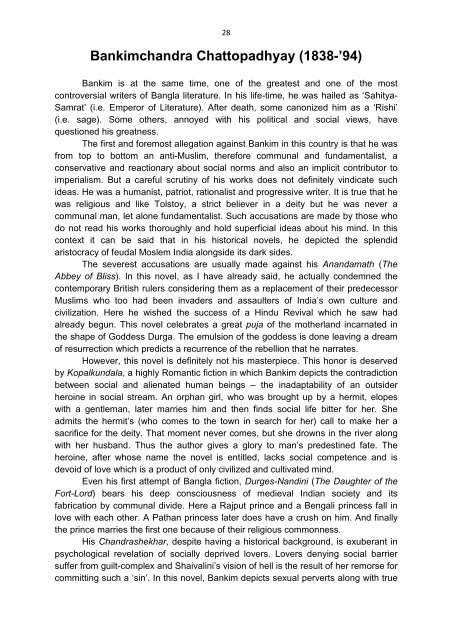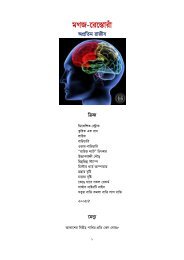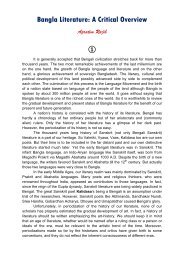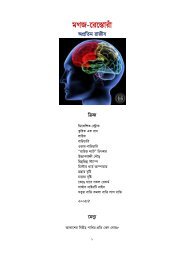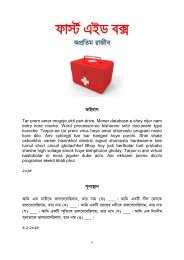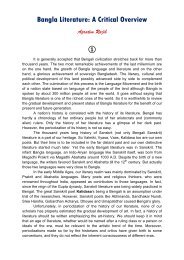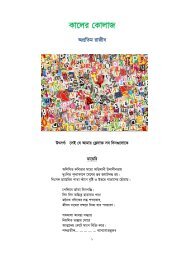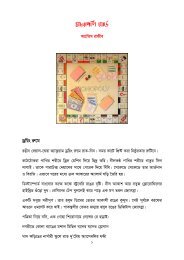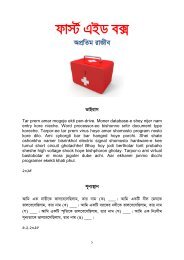BLiterature-Apratim
Create successful ePaper yourself
Turn your PDF publications into a flip-book with our unique Google optimized e-Paper software.
28<br />
Bankimchandra Chattopadhyay (1838-’94)<br />
Bankim is at the same time, one of the greatest and one of the most<br />
controversial writers of Bangla literature. In his life-time, he was hailed as ‘Sahitya-<br />
Samrat’ (i.e. Emperor of Literature). After death, some canonized him as a ‘Rishi’<br />
(i.e. sage). Some others, annoyed with his political and social views, have<br />
questioned his greatness.<br />
The first and foremost allegation against Bankim in this country is that he was<br />
from top to bottom an anti-Muslim, therefore communal and fundamentalist, a<br />
conservative and reactionary about social norms and also an implicit contributor to<br />
imperialism. But a careful scrutiny of his works does not definitely vindicate such<br />
ideas. He was a humanist, patriot, rationalist and progressive writer. It is true that he<br />
was religious and like Tolstoy, a strict believer in a deity but he was never a<br />
communal man, let alone fundamentalist. Such accusations are made by those who<br />
do not read his works thoroughly and hold superficial ideas about his mind. In this<br />
context it can be said that in his historical novels, he depicted the splendid<br />
aristocracy of feudal Moslem India alongside its dark sides.<br />
The severest accusations are usually made against his Anandamath (The<br />
Abbey of Bliss). In this novel, as I have already said, he actually condemned the<br />
contemporary British rulers considering them as a replacement of their predecessor<br />
Muslims who too had been invaders and assaulters of India’s own culture and<br />
civilization. Here he wished the success of a Hindu Revival which he saw had<br />
already begun. This novel celebrates a great puja of the motherland incarnated in<br />
the shape of Goddess Durga. The emulsion of the goddess is done leaving a dream<br />
of resurrection which predicts a recurrence of the rebellion that he narrates.<br />
However, this novel is definitely not his masterpiece. This honor is deserved<br />
by Kopalkundala, a highly Romantic fiction in which Bankim depicts the contradiction<br />
between social and alienated human beings – the inadaptability of an outsider<br />
heroine in social stream. An orphan girl, who was brought up by a hermit, elopes<br />
with a gentleman, later marries him and then finds social life bitter for her. She<br />
admits the hermit’s (who comes to the town in search for her) call to make her a<br />
sacrifice for the deity. That moment never comes, but she drowns in the river along<br />
with her husband. Thus the author gives a glory to man’s predestined fate. The<br />
heroine, after whose name the novel is entitled, lacks social competence and is<br />
devoid of love which is a product of only civilized and cultivated mind.<br />
Even his first attempt of Bangla fiction, Durges-Nandini (The Daughter of the<br />
Fort-Lord) bears his deep consciousness of medieval Indian society and its<br />
fabrication by communal divide. Here a Rajput prince and a Bengali princess fall in<br />
love with each other. A Pathan princess later does have a crush on him. And finally<br />
the prince marries the first one because of their religious commonness.<br />
His Chandrashekhar, despite having a historical background, is exuberant in<br />
psychological revelation of socially deprived lovers. Lovers denying social barrier<br />
suffer from guilt-complex and Shaivalini’s vision of hell is the result of her remorse for<br />
committing such a ‘sin’. In this novel, Bankim depicts sexual perverts along with true


